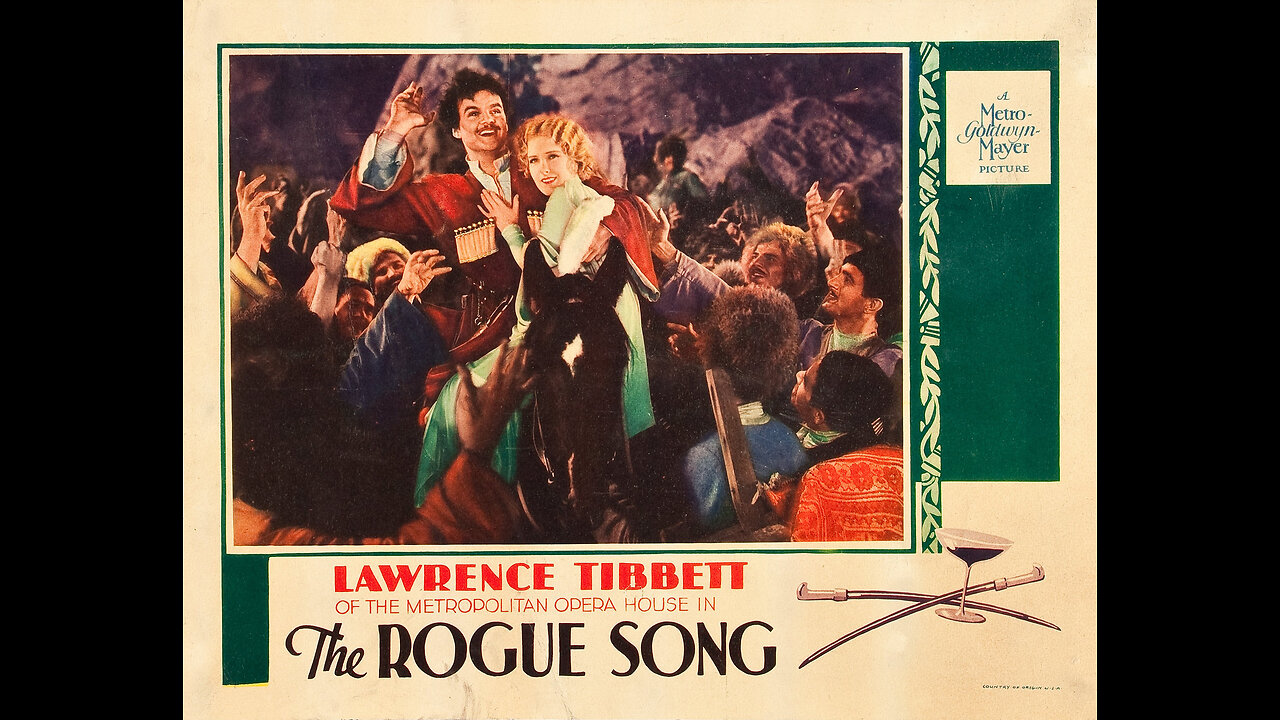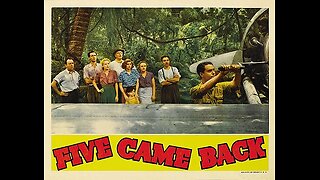Premium Only Content

"The Rogue Song" (1930) All Surviving Elements Combined!
The Rogue Song is a 1930 American pre-Code romantic and musical film that tells the story of a Russian bandit who falls in love with a princess, but takes his revenge on her when her brother rapes and kills his sister. The Metro-Goldwyn-Mayer production was directed by Lionel Barrymore and released in two versions, with and without sound. Hal Roach wrote and directed the Laurel and Hardy sequences and was not credited. The film stars Metropolitan Opera singer Lawrence Tibbett—who was nominated for an Academy Award for Best Actor for his performance—and Catherine Dale Owen. Laurel and Hardy were third-billed; their sequences were filmed at the last minute and interspersed throughout the film in an attempt to boost its potential box-office appeal.
This film, MGM's first all-talking Technicolor film, is partially lost as there are no known complete prints of this film. Fragments do exist.
•PLOT:
The story takes place in the Russian Empire in the year 1910. Yegor (Lawrence Tibbett), a dashing (as well as singing) bandit leader meets Princess Vera (Catherine Dale Owen) at a mountain inn. They fall in love, but the relationship is shattered when Yegor kills Vera's brother, Prince Serge, for raping his sister, Nadja, and driving her to suicide. Yegor kidnaps Vera, forcing her to live a life of lowly servitude among the bandits. Vera manages to outwit Yegor, who is captured by soldiers and flogged. Vera begs Yegor's forgiveness. Although still in love with each other, they realize they cannot be together.
•PRODUCTION:
The film is MGM's first all-talking, all-color (Technicolor) production. It was also the screen debut of Lawrence Tibbett, a world-renowned star of the Metropolitan Opera. The film is notable today as Laurel and Hardy's first and only appearance in a color feature film (all of their feature films before and after were shot in black-and-white; their only other professionally shot color film was the wartime short The Tree in a Test Tube), although they were only minor players in the film.
The film was adapted by John Colton and Frances Marion from the operetta Gipsy Love, book by Robert Bodanzky and A. M. Willner, music by Franz Lehár.
Production was supervised by Paul Bern, and the anticipated 30-day shooting schedule began on August 29, 1929. The studio executives' response to the daily "rushes" was that the film was not working well and needed help. MGM borrowed Laurel and Hardy from Hal Roach, and after negotiations between Roach and Thalberg, Roach agreed to write and direct their scenes. The final film has eight scenes with the comedy duo. Principal photography ended on October 11.
•PRESERVATION:
Although the film is considered to be lost, as there are no known complete prints, some fragments have been found. A two and a half minute fragment that had been cut out of the film by a local projectionist was found in a bookstore in Cambridge, Massachusetts in 1981, it featured a comic segment with Laurel and Hardy hiding in a cave in which a bear has taken shelter. Another 500 foot piece, about 10 minutes long, which showed a ballet sequence by Albertina Rasch was found in Maine in 1998 and was restored by UCLA. Another reel of assorted clips is in the Czech Film Archive; it was screened at a convention in 1995. Another short fragment shows Lawrence Tibbett singing to Catherine Dale Owen as they are caught in a storm.
The film's trailer, which includes Laurel and Hardy, is extant except for the first 60 seconds, which were lost due to decomposition; the remainder was transferred to safety stock by UCLA.[3] In the trailer, Tibbett sings "White Dove" to Owen. A short segment featuring the comics Laurel & Hardy is also seen in which Laurel has apparently swallowed a bee.
In addition to those film fragments, the complete soundtrack of the film and the trailer survived because it was re-recorded on Vitaphone disks for theaters that did not have optical sound systems, such as the Movietone system, which MGM usually utilized.
The estate of Lawrence Tibbett held a color copy of the entire Rogue Song for many years after his death. Tibbett liked the film and showed it frequently to his friends. The late Allan Jones was a regular visitor and friend and reportedly gained possession of the print, which his son Jack Jones destroyed because of nitrate film decomposition. Tibbett had recorded some of the songs from the film in studio recordings released by RCA Victor.
MGM held the negative of reel four until early 1974.
-
 1:15:10
1:15:10
A Warm Pug
5 months ago"5 Came Back" (1939) Chester Morris, Lucille Ball & John Carradine
1811 -
 23:12
23:12
Jasmin Laine
6 hours agoCBC TURNS on Carney—Poilievre Speech Goes VIRAL, ROASTS Canada’s Elites
12.7K15 -
 1:16:21
1:16:21
The Daily Signal
5 hours ago $2.33 earned🚨BREAKING: Tim Walz Self-Destructs Over BILLIONS in Fraud Under His Watch, War Crime Allegations
14K2 -
 9:08
9:08
China Uncensored
7 hours agoIndia And China Are Headed To Another War
3.91K8 -
 12:04
12:04
Vedic compatability astrology
3 hours ago"My Persian grandmother's secret beauty potions now on Amazon"
3.02K -
 12:44:59
12:44:59
LFA TV
1 day agoLIVE & BREAKING NEWS! | MONDAY 12/01/25
205K22 -
 1:01:31
1:01:31
OFFICIAL Jovan Hutton Pulitzer Rumble
3 hours agoWhen Evil Masquerades As Patriots and Freedom! A Social Experiment
9.82K3 -
 4:47:14
4:47:14
DeadMomAlive
8 hours agoRumble Premium Creator! WE DID IT! THank you for all your support!
4.96K1 -
 2:48:00
2:48:00
Nikko Ortiz
3 hours agoPistols In Tabor... | Rumble LIVE
18.4K1 -
 1:37:59
1:37:59
ThisIsDeLaCruz
6 hours ago $0.16 earnedWhat Fans Never Hear: Luke Bryan’s Engineer Tells All
3.17K1